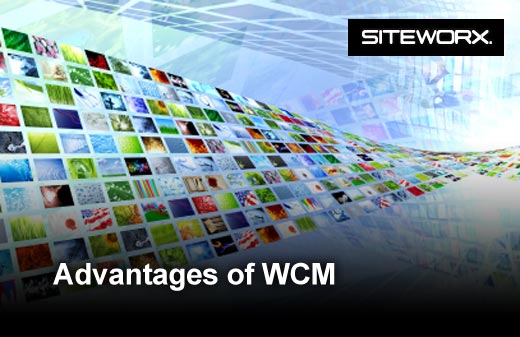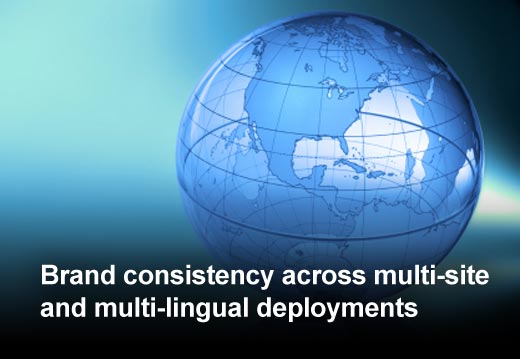Companies in a variety of vertical industries are rapidly adopting Web content management (WCM) systems, and every vertical has a unique set of business drivers. Media and entertainment companies turn to WCM for content delivery and monetization (digital advertising, digital video, digital signage, in-game advertising, podcasts, etc.), while global brands are investing in WCM to extend their brands digitally both far and wide (i.e., cross-device/platform, social media, transactional marketing, etc.). Financial services, government, business-to-business (B2B), manufacturers, and healthcare/pharmaceutical companies are also investing heavily in the WCM category.
According to Siteworx, Inc., an interactive agency specializing in WCM and CMS deployment, search and analytics, while there’s still room for significant growth in the category, by all accounts, we’re entering the late-majority phase of WCM adoption. Businesses that fail to seriously consider how a WCM solution can drive business value will soon find themselves at a significant competitive disadvantage.
WCM represents a significant investment, which is why a comprehensive understanding of return on investment (ROI) measurement is vital. Ideally, companies will conduct an initial ROI calculation prior to their first implementation. This calculation can be difficult given the significant unknowns associated with re-engineering business processes and understanding target audience needs. However, an attempt should be made to create a baseline from which to assess future scope and enhancement decisions.
This slideshow features the key areas Siteworx recommends examining when calculating WCM ROI.
Click through for key factors you should consider when evaluating Web content management (WCM) system ROI, provided by Siteworx, Inc.
When considering how to measure publishing efficiencies, it’s important to ask the question, “How much time does it take to publish a new piece of digital content within my organization?” With minimal analysis, you may be surprised to learn that incremental costs of publishing can be excessive. It’s not unusual to find that large organizations require as much as 80 hours per piece of content without the aid of a WCM system.
If 80 hours per piece of content sounds like a high estimate, consider how many organizational layers each piece of content must travel: a writer, editor, manager (which may include different managers from multiple levels of management in varying departments), and legal. For multi-language sites, add translation times. All this effort takes place, of course, before the project even reaches a designer. Next, a designer will create the front-end look and feel of the content, and a developer or multiple developers will need to create front-end HTML and CSS and back-end database integrations as necessary. Then, the content will be published to Web and database servers.
A “best in class” WCM tool which effectively enables every individual to complete their required tasks efficiently and with minimal friction, can help companies reduce this time to as little as 20 hours per piece of content. A well-managed financial services company that rigorously analyzed its publishing process discovered that it was spending 320 hours (or 2 months of labor) on every piece of content generated. Capturing this wasted time can translate into phenomenal financial savings on a monthly basis.
Reduced customer service costs can also serve as a source of ROI for WCM investments. For example, visit Bank of America’s help page. The first item listed on the site concerns how to find a routing number. This is a very simple question to answer, and by making the solution easily findable for users on the website, Bank of America reduces a large number of unnecessary calls to its customer service department. Companies with call centers can reduce their most frequent call center questions by placing the answers to those questions in frequently asked questions (FAQ) pages or help updates on their website. While these savings are not as significant as those resulting from reduced publishing efficiencies, they can be extremely relevant in industries such as telecommunications, where call center support is a significant cost driver.
A company’s inability to change or remove content from its website within a short amount of time can have substantial financial repercussions. One financial services company approached Siteworx for WCM implementation after being repeatedly penalized for content it was unable to change at the request of regulators. The client was routinely audited by all 50 states on insurance content on its websites and was facing regulatory penalties to the tune of $50,000 to $100,000 each month due to its slow response to auditor requests to remove or modify site content. A WCM implementation that allows rapid and efficient updates to Web content can immediately save costs for companies that are suffering similar unnecessary regulatory penalties.
WCM implementation has noteworthy IT cost benefits with regard to potential hardware consolidation via the cloud. Enterprise-class WCM products’ sophisticated out-of-the-box clustering capabilities make quickly scaling capacity much easier than for organizations relying on outdated WCM solutions or even Web servers serving static HTML content.
To understand how a cloud deployment model can translate to significant financial savings, consider sites that experience seasonal variation in their levels of Web traffic. Tax companies, for example, have more traffic between January and April than between May and December, and media sites will experience peaks in Web traffic based on current events. Using an on-premise only model, companies are forced to manage the hardware, infrastructure and bandwidth associated with supporting peak volume during non-peak periods. With a cloud deployment, companies can throttle these variables up or down based on their actual month-by-month usage. This flexible deployment model enables companies to ramp up server capacity during periods of increased traffic, without having to pay for peak charges during off-peak times.
WCMs can help an organization tailor its website content towards users arriving at the site through targeted landing pages. This tactic results in increased time on site and reduced bounce rates. In addition to the direct benefits of improved user engagement, low bounce rates can boost the site in Google’s organic rankings, which can ultimately improve organic site traffic.
WCMs can also enable easier online site testing and more effective improvements to the site. Online testing, such as A/B testing or multivariate testing, can help identify untapped opportunities for conversions. In Siteworx’ experience, companies can gain increases in conversion as much as 67 percent in direct conversions, and 33 percent in cross-selling and up-selling through personalization.
The ability to cross-sell and up-sell on Web and mobile properties in a largely automated manner can be a critical revenue driver for organizations. The American Diabetes Association (ADA) provides a great example of cross-selling and up-selling in the way it has chosen to present additional advertising content through its WCM.
The ADA website features multiple promotions throughout its site that are initially set to a baseline of standard promotions. However, as the WCM “learns” more about each individual user and the user’s behaviors and preferences, it tailors the promotions to match the user’s interests. For example, after buying a healthy eating cookbook from the site, the user would likely be presented with two promotions relating to cookbooks, rather than a more generic or unrelated promotion. Such promotions present engaging opportunities which promote user engagement and conversion. Cross-selling and up-selling work in effectively the same way from a Web perspective – and they both can take your brand from cookbooks to cash in the coffers.
A user’s overall experience with and impression of a brand in the digital space, while difficult to quantify, affects that brand’s bottom line in ways the brand might not even recognize.
When a top-five global management consulting firm engaged Siteworx for website redesign, its perception was that potential clients were not utilizing the site to evaluate or purchase their services. Rather, the company believed that referrals were coming from contacts within its business network and from colleagues of clients. When Siteworx spoke with contacts at the Fortune 100 companies who composed the consultancy’s client base, however, a different portrait emerged.
While initial referrals mattered, 80 percent of prospective clients were relying on the corporate website to identify the firm’s primary lines of business, expertise and examples of thought leadership, such as white papers. Through this analysis, the firm recognized that an unpolished brand experience online, even though the site itself was not necessarily generating conversions, could be a disqualifier for their highly-selective business buyers.
Leading brands should recognize that for many buyers — both business and consumer — their website is the modern-day equivalent of a well-designed business card in the hands of their sales team. Your buyers will most likely seek you out online and will develop perceptions about the quality of your products and services based on what they find–WCM implementations enable brands to control their brand presence, regardless of the number of sites or sub-brands within their brand family.
WCM implementations can help to ensure brand consistency across multi-site deployments. A Siteworx non-profit client provides an example: the organization’s Web presence featured a home site belonging to the organization. This umbrella site for the organization served as the focal point for the nonprofit’s online brand. However, websites for state-based affiliates displayed a unique, variable Web presence without a consistent brand influence. WCM enabled the creation of content in a brand template, which was consistent from the national organization down to the state-level sites. State affiliates could create highly specialized content while maintaining visual consistency with the national organization, and could even present the national organization’s content if the affiliates did not have the resources to manage their own local content.
WCM implementations can also aid in maintaining brand-consistency across multi-lingual deployments that necessitate management of the brand across time zone, linguistic and national borders. At the enterprise level, WCMs can create numerous sites that can be managed from a single template in multiple languages. To give an idea of the complexity involved, the rule of thumb in English-Spanish translation is that 33 percent more content space is required to communicate the same information in Spanish than in English. Using WCM, templates can be automatically resized and rebuilt, with the Spanish content ported into the template. Users of the Spanish site encounter additional space on the site for a brand-consistent experience across the Americas.
Distributing highly sharable content is extremely important – and a significant time investment without WCM. With WCM, a company can create content once and publish it everywhere. Fresh content can be pushed to social media outlets, such as Facebook and Twitter and YouTube, as part of the publishing model. This results in the presentation of a consistent brand experience across diverse channels.
The picture becomes even rosier when email campaign management comes into play. Email campaign management is often handled by a separate program or department, or even outsourced to an entirely different group. Today, companies can design email processes that leverage their WCM and the assets within the WCM to develop, store and manage email campaigns.
And what about those brand-consistent mobile phones and tablet devices? Many WCMs enable the automated publishing of content through these channels, and some even go a step further to manage print collateral and content. For example, a Siteworx client in the insurance vertical utilizes a WCM system to manage their print assets. When copy and graphics are entered in the system, they are stored and managed in standard and native formats and then assembled outside of the WCM system as camera-ready art. Thus, any print assets created once as content elements within the WCM can be transformed seamlessly to deliver a consistent brand experience across platforms, including the Web, social media, email and print. This translates to considerable savings, as well as the maintenance of a consistent brand experience.
The business landscape is ripe with examples of first-mover advantage. Ten years after it launched, Blogger remains the industry leader ahead of WordPress and Moveable Type, largely due to its position as first-mover. When Henry Ford Hospital performed the first live surgery on Twitter, it more than doubled its Twitter following, which catapulted its number of followers to continued growth. Sherman Health, which performed the second surgery, increased its Twitter following by roughly a third. WCMs enable companies to launch new products and services before their competitors and to respond to market developments more nimbly because they help to significantly streamline publishing processes.
It is worth noting that Sherman Health, while not experiencing as significant an impact as first-mover Henry Ford, still garnered many new followers. Replicating the actions of a competitor can still be advantageous, especially if competitive reaction time is minimized. The probability of gaining market share is higher for companies that are capable of emulating the competition quickly. This is especially important for those in competitive industries in which many other companies are innovating. If your organization can be rapid second-movers in a matter of days or weeks, as opposed to months, it can see improved market share results.
Companies that sell Web products to other companies that utilize those sites to gain customers can achieve ROI for WCM implementations very quickly. For example, Siteworx worked with an insurance company selling portals to companies to help their employees manage health insurance. A WCM system allowed them to ramp up new websites more quickly, both cutting operational overhead and assisting in the sales process through faster delivery of product. Although this a scenario is fairly narrow, the general principals and financial drivers also apply to providers of shared internal services, such as IT resources which help marketing and other business units create websites.














